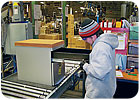
At the Metalworks assembly plant in Ludington, MI, a worker installs drawer cushions. Photo courtesy Metalworks Great Openings
Metalworks Great Openings (Ludington, MI) makes sheet-metal filing cabinets, bookcases, hutches and other office furniture. All products are built to order. In some cases, orders are electronically downloaded directly into the company’s scheduling system.
The company’s 120,000 square foot production facility includes equipment for stamping, notching, laser cutting, robotic welding and powder coating. Metalworks’ products are available in more than 1,000 colors.
Some 10 years ago, the company started down the path toward lean manufacturing. The shop floor was organized according to the principles of 5S. Value streams were established to connect the fabrication, paint and assembly departments to ensure a smooth flow of product. Each value stream is paid a bonus for staying on schedule. The bonus pool is decreased for defects passed to the customer.
A key part of the company’s continuous improvement activities is a standardized problem-solving system, which is applied to every department, from the shop floor to the front office. Under the system, the company compiles Pareto charts on problems-such as customer complaints, manufacturing defects, workplace injuries or payroll errors-on a rolling three-month basis. Process teams meet weekly to solve whatever problem tops their chart for that time period. The teams then attack that problem following the lean dictum of plan-do-check-act.
“A [particular problem] may show up every two weeks, so if you just look at each incident, it’s hard to track a trend,” explains Scott Lakari, vice president of operations at Metalworks. “With the rolling three-month analysis, you see problems clearly. You focus on the top problem, instead of chasing down every issue that comes in.”
For example, at the end of one three-month period, the top customer complaint concerned mobile file cabinets that were shipped without castors. For packaging reasons, the castors are not attached to the cabinets during final assembly. Instead, a bag with all the necessary hardware is placed inside a drawer for the consumer to assemble. The drawers are then locked to keep them in place during shipping.
“The problem was, if someone forgot to put in the castor kit, we had no way of knowing [without unlocking the drawer and opening it],” says Lakari.
Using the company’s problem-solving methodology, the cabinet team came up with a simple, yet elegant solution: attach a ribbon to the castor kit. The ribbon is draped outside the drawer when the kit is placed inside. Now, everyone on the line can tell instantly if the kit is in place. A few pennies spent on ribbon has saved the company big dollars on express shipping of castor kits, not to mention the less tangible cost of lost consumer goodwill.
The ribbon solution is one of many good ideas that have been generated by Metalworks employees. Indeed, Metalworks has enjoyed a 55 percent success rate when implementing employee improvement suggestions and a 91 percent closure rate on process problems.
Metalworks’ continuous improvement activities have yielded impressive results. Workplace injuries have been reduced by 88 percent since 2002, and the company received an ergonomic improvement award from the State of Michigan in 2006. Customer lead times have been reduced by 33 percent to 50 percent, and the rate of customer complaints per million opportunities has shrunk by 75 percent. Between 2004 and 2008, the cost of scrap and rework as a percentage of sales decreased by 68 percent. Over that same time period, labor costs associated with assembly have decreased 35 percent, and companywide, direct labor costs declined by 15 percent. Overall, the company has reaped a total cost-savings of $6.27 million.



